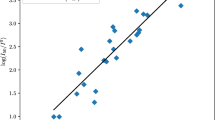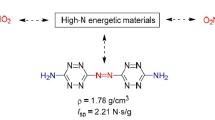Abstract
Nitro compounds are capable of rapid chemical decompositions with a large amount of energy releases and hence pose significant thermal explosion hazards. Molecular simulation has been well established and demonstrated as an effective tool to predict physical and/or chemical properties of energetic materials, such as onset temperature, heat of reaction, and shock sensitivity. In this work, a simple relationship for predicting the onset temperature of nitro aromatic compounds containing other functional groups is developed based on their molecular structures. The results have shown that the thermal onset temperature of a specific nitro aromatic compound is strongly related to its excitation energy (a singlet state to triplet state). The predicted onset temperatures show very good agreement with respect to the measured onset temperatures by differential scanning calorimetry. Deviations compared to the experimental values are very small. These correlations can be used to computationally screen new nitro compounds for their thermal explosion hazards. These correlations can also be applied as a preliminary thermal analysis method and expedite the evaluation process of new energetic materials.


Similar content being viewed by others
References
Iwata Y, Momota M, Koseki H. Thermal risk evaluation of organic peroxide by automatic pressure tracking adiabatic calorimeter. J Therm Anal Calorim. 2006;85:617–22.
Wei C, Rogers WJ, Mannan MS. Layer of protection analysis for reactive chemical risk assessment. J Hazard Mater. 2008;159:19–24.
Wang Q, Rogers WJ, Mannan MS. Thermal risk assessment and ranking for reaction hazards in process safety. J Therm Anal Calorim. 2009;98:225–33.
Improving Reactive Hazard Management. U.S. Chemical Safety and Hazard Investigation Board Hazard Investigation, Washington, DC, 2002.
Olah GA, Spuire DR. Chemistry of energetic materials. San Diego: Academic Press; 1991.
Brill TB. Energetic materials: detonation, combustion. Amsterdam: Elsevier; 2003.
Keshavarz MH, Motamedoshariati H, Pouretedal HR, Tehrani MK, Semnani A. Prediction of shock sensitivity of explosives based on small scale gap test. J Hazard Mater. 2007;145:109–12.
Ding SD, Bai CY, Liu ZP, Wang YZ. Enhanced thermal stability of poly(p-dioxanone) in melt by adding an end-capping reagent. J Therm Anal Calorim. 2008;94:89–95.
Ando T, Fujimoto Y, Morisaki S. Analysis of differential scanning calorimetric data for reactive chemical. J Hazard Mater. 1991;28:251–80.
van Ekeren PJ, Bevers ERT. Temperature calibration of a high-pressure DSC for measurements in ammonia. J Therm Anal Calorim. 2007;90:931–4.
Chou YP, Hou HY, Chang RH, You ML, Peng JY, Shu CM. Thermal decomposition of cumene hydroperoxide in the presence of three incompatible substances by isothermal microcalorimetry and high performance liquid chromatography. J Therm Anal Calorim. 2009;96:771–5.
Dremin AN. Discoveries in detonation of molecular condensed explosives in the 20th century. Combust Explos Shock Waves. 2000;36:704–15.
Wu CJ, Fried LE. Ab initio study of RDX decomposition mechanisms. J Phys Chem A. 1997;101:8675–9.
Gindulyté A, Masaa L, Huang L, Karle J. Proposed mechanism of 1,1-diamino-dinitroethylene decomposition: a density functional theory study. J Phys Chem A. 1999;103:11045–51.
Alavi S, Reilly LM, Thompson DL. Theoretical predictions of the decomposition mechanisms of 1,3,3-trinitroazetidine (TNAZ). J Chem Phys. 2003;119:8297–304.
Badgujar DM, Talawar MB, Asthana SN, Mahulikar PP. Advances in science and technology of modern energetic materials: an overview. J Hazard Mater. 2008;151:289–305.
Brill TB, James KJ. Kinetics and mechanisms of thermal decomposition of nitroaromatic explosives. Chem Rev. 1993;93:2667–92.
Saraf SR, Rogers WJ, Mannan MS. Application of transition state theory for thermal stability prediction. Ind Eng Chem Res. 2003;42:1341–6.
Wang Q, Ng D, Mannan MS. Study on the reaction mechanism and kinetics of the thermal decomposition of nitroethane. Ind Eng Chem Res. 2009;48:8745–51.
Manaa MR, Fried LE. DFT and ab initio study of the unimolecular dissociation of the lowest singlet and triplet states of nitromethane. J Phys Chem A. 1998;102:9884–9.
Duh YS, Lee C, Hsu CC, Hwang DR, Kao CS. Chemical incompatibility of nitrocompounds. J Hazard Mater. 1997;53:183–94.
Wang Q, Zhang Y, Rogers WJ, Mannan MS. Molecular simulation studies on chemical reactivity of methylcyclopentadiene. J Hazard Mater. 2009;165:141–7.
Wang Q, Wei C, Porez LM, Rogers WJ, Hall MB, Mannan MS. Thermal decomposition pathways of hydroxylamine: theoretical investigation on the initial steps. J Phys Chem A. 2010;114:9262–9.
Wang Q, Mannan MS. Prediction of thermochemical properties for gaseous ammonia oxide. J Chem Eng Data. 2010;55:5128–32.
Frisch MJ, Trucks GW, Schlegel HB, Scuseria GE, Robb MA, Cheeseman JR, Montgomery Jr JA, Vreven T, Kudin KN, Burant JC, Millam JM, Iyengar SS, Tomasi J, Barone V, Mennucci B, Cossi M, Scalmani G, Rega N, Petersson GA, Nakatsuji H, Hada M, Ehara M, Toyota K, Fukuda R, Hasegawa J, Ishida M, Nakajima T, Honda Y, Kitao O, Nakai H, Klene M, Li X, Knox JE, Hratchian HP, Cross JB, Bakken V, Adamo C, Jaramillo J, Gomperts R, Stratmann RE, Yazyev O, Austin AJ, Cammi R, Pomelli C, Ochterski JW, Ayala PY, Morokuma K, Voth GA, Salvador P, Dannenberg JJ, Zakrzewski VG, Dapprich S, Daniels AD, Strain MC, Farkas O, Malick DK, Rabuck AD, Raghavachari K, Foresman JB, Ortiz JV, Cui Q, Baboul AG, Clifford S, Cioslowski J, Stefanov BB, Liu G, Liashenko A, Piskorz P, Komaromi I, Martin RL, Fox DJ, Keith T, Al-Laham MA, Peng CY, Nanayakkara A, Challacombe M, Gill PMW, Johnson B, Chen W, Wong MW, Gonzalez C, Pople JA. Gaussian 03, Revision C.02, Gaussian, Inc., Wallingford CT, 2004.
Becke AD. Density-functional thermochemistry. 3. The role of exact exchange. J Chem Phys. 1993;98:5648–52.
Lee C, Yang W, Parr RG. Development of the Colle-Salvetti correlation-energy formula into a functional of the electron density. Phys Rev B. 1988;37:785–9.
Frisch MJ, Pople JA, Binkley JS. Self-consistent molecular-orbital methods 25. Supplementary functions for Gaussian-basis sets. J Chem Phys. 1984;80:3265–9.
Acknowledgements
This research was supported by the Oklahoma State University Department of Fire Protection & Safety, and School of Chemical Engineering. We thank the supercomputing facility at Oklahoma State University for computer time.
Author information
Authors and Affiliations
Corresponding author
Rights and permissions
About this article
Cite this article
Wang, Q., Wang, J. & Larranaga, M.D. Simple relationship for predicting onset temperatures of nitro compounds in thermal explosions. J Therm Anal Calorim 111, 1033–1037 (2013). https://doi.org/10.1007/s10973-012-2377-4
Received:
Accepted:
Published:
Issue Date:
DOI: https://doi.org/10.1007/s10973-012-2377-4




